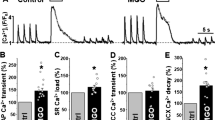Abstract.
The relative functional importance of potassium channels and cGMP-dependent pathways in the relaxation of vascular smooth muscle to the novel nitric oxide donor, diethylamine NONOate (DEA NONOate), was investigated in a resistance artery. The contribution from cGMP-dependent signalling pathways was examined by exposing arteries to 1H-[1,2,4]oxadiazolo[4,3-a]quinoxalin-1-one (ODQ), a selective inhibitor of soluble guanylyl cyclase, while the contribution through potassium channels was assessed with different sub-type-selective potassium channel blockers.
DEA NONOate (3 nM–10 µM) evoked sustained relaxation in isolated segments of the rat small mesenteric artery contracted with phenylephrine (pEC50=6.7±0.2; n=11). The relaxation was attenuated significantly by either ODQ (10 µM; pEC50=5.8±0.4; n=7) or charybdotoxin (ChTX; 50 nM; pEC50=6.3±0.2; n=4), a peptide blocker of large conductance, calcium-activated potassium channels (BKCa). The inhibitory effects of ODQ and ChTX were additive (pEC50=5.1±0.4; n=9). The selective inhibitor of BKCa channels, iberiotoxin (IbTX; 30 nM), and 4-aminopyridine (4-AP; 1 mM), an inhibitor of voltage-gated potassium channels (Kv), failed to modify DEA NONOate-evoked relaxation. However, in the combined presence of both ODQ and either IbTX or 4-AP the relaxation was attenuated significantly (n=3). The blocker of ATP-modulated potassium channels (KATP), glibenclamide (10 µM), and of small conductance calcium-activated potassium channels (SKCa), apamin (30 nM), each failed to affect ODQ-sensitive or -resistant relaxations to DEA NONOate (n=3).
In conclusion, relaxation to DEA NONOate in the rat isolated, small mesenteric artery can occur via both cGMP-dependent (ODQ-sensitive) and -independent (ODQ-resistant) mechanisms. However, the contribution made to relaxation by potassium channels appears to be unmasked following pharmacological attenuation of cGMP-dependent signalling pathways. The inhibitory action of ChTX suggests part of the cGMP-insensitive component involves the activation of potassium channels, a suggestion supported by the inhibitory actions of 4-AP and IbTX in the absence of cGMP.
Similar content being viewed by others
Author information
Authors and Affiliations
Additional information
Electronic Publication
Rights and permissions
About this article
Cite this article
Sampson, L.J., Plane, F. & Garland, C.J. Involvement of cyclic GMP and potassium channels in relaxation evoked by the nitric oxide donor, diethylamine NONOate, in the rat small isolated mesenteric artery. Naunyn-Schmied Arch Pharmacol 364, 220–225 (2001). https://doi.org/10.1007/s002100100453
Received:
Accepted:
Issue Date:
DOI: https://doi.org/10.1007/s002100100453




